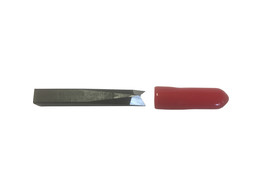Using a threaded tap and cutting pad is quite simple. As this is done manually, the choice of wood is very important (ideal woods are boxwood and hornbeam). With the tap, it is theoretically possible to make external threads of unlimited length.
- Cutting blade can be replaced
- Cuts long-term threads on most types of wood
Check the dowel carefully. Hardwood dowels with a straight grain work best. Check that the dowel is round and not oval. Try the dowel in the threaded dowel to check that it is not too tight or too loose.
With most dowels, you need to use lubricant. Linseed oil or tung oil work best. You can clean these with spirit or turpentine if you want to paint your finished project. With some types of hardwood, you need to soak the part of the dowel you want to use. This soaking may take a few minutes to a few days. The better soaked the dowel is, the easier it will be to cut and the cleaner the threads will be.
Before you start cutting the threads, chamfer the end of the dowel. You can do this by sanding the dowel or using a chamfer tool. This chamfer only needs to be about 1/8" down. This makes it easier to thread.
It is easier to cut threads if you clamp the dowel in a sage or some other way to hold the dowel firmly. But be careful not to damage the dowel. Insert the dowel into the large smooth end of the thread-cutting tool.
As you start cutting, you may need to apply a little downward pressure to get the tool to bite down properly. Once you have started cutting, always use a forward motion. If the blade jams, go back no more than a quarter turn to remove chips and then continue cutting new wires. If you need to remove and reinstall the wire cutting tool, align the wires you have already cut. If the tool is not properly aligned, it will cut new wires and ruin those already made.
It is a good practice to do a test on a block of waste wood. It won't be long before you will use this in more of your projects.
Properties
- SB208
- Willy Vanhoutte
- 5407008211189













